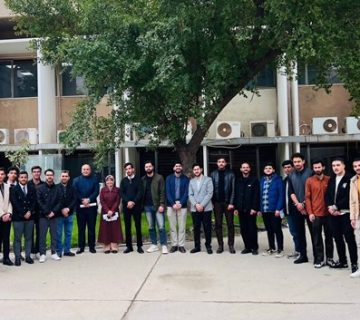The Chemical Engineering Department at the College of Engineering, University of Baghdad, held a Ph.D thesis examination titled:
“Experimental and Numerical Study of Heavy Naphtha Cracking Using Zeolite and Microwave Energy“
By the student Muataz Mohammed Sulaiman and supervised by Prof. Dr. Hasan Ferhood Makki. The examination committee consisted of Prof. Dr. Wadood Tahir Mohammed as Chairman and the membership of Prof. Dr. Naseer Abbood Al Haboubi, Prof. Dr. Haider A. Al-Jendeel, Asst. Prof. Dr. Samar K. Theydan and Asst. Prof. Dr. Sarmad Fouad Jaber. After conducting the public discussion and listening to the student’s defense, the thesis was accepted. The thesis was summarized as follows:
Chemical synthesis by microwave energy offers several advantages and is significant for the scientific and engineering fields. Microwaves have been employed in a wide range of inorganic and organic chemical syntheses, acting as a source of heat.
This study presents a novel combination of microwave radiation and ZSM-5 catalyst to crack the heavy naphtha. ZSM-5 catalysts with different (SiO2/Al2O3) ratio (10, 20, and 50) were used in experiments with different microwave radiation (750, 1000, and 1250) W, preheating temperatures (150, 200, and 250 ˚C) and flowrate (2, 4, and 6 l/hr) with and without nitrogen injection. Microwave applications in cracking techniques gives superior results compared to conventional methods. Moreover, Application of the microwave methodology which lead to a reduce the reaction time and increase the conversion.
This research also developed a full three-dimensional model using COMSOL Multiphysics to continuously couple Maxwell’s equation with the equations governing heat and momentum transport (COMSOL, 6.2) and and comparison between numerical and experimental results of heavy naphtha cracking process in a continuous microwave system.
The cracking products were analysed by gas chromatography and mass spectroscopy. The catalysts were characteristic by chemical, physical, and microstructural properties. The catalysts have been tested using X-ray fluorescence (XRF), Brunauer-Emmett-Teller (BET), Scanning electron microscopy (SEM), Fourier – Transform Infrared Spectroscopy (FTIR), and X-ray diffraction (XRD).
The chemical reactions with microwave technique and catalytic achieve the cracking with lower temperature than conventional processes. Accordingly, the cracking of heavy naphtha was carried out by microwave technique due to the role of hot spots that are sometimes encountered in microwave chemistry.
The Si/Al ratio of the ZSM-5 (10) gives best results of cracking reaction conversion (77.6%) at microwave power 1250 W, flowrate 2 l/hr and preheating temperature 200˚C with nitrogen injection than ZSM-5 (20) and ZSM-5 (50), this means that the zeolites with high (SiO2/Al2O3) ratio have low conversion. Therefore, a catalyst with higher amount of acid sites caused higher cracking and then best conversion and higher conversion with nitrogen injection due to re-activation of acid sites then facilitate the cracking. Generally, the increasing of microwave power and preheating temperature increases the reaction conversion while the increase of flowrate decrease the reaction conversion with and without nitrogen injection.
The researcher recommended studying the oil residue may give good result with microwave process, can use multi- microwave reactor in series, and used catalyst carried on metal.








